written and photographed by Mary L. Peachin
Jul 1999, Vol. 3 No. 9
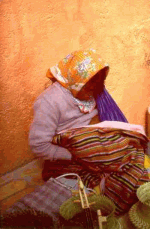 Tarahumara men run swiftly up the steep trails of the Barrancha del Cobre (Copper Canyon) in simple leather thongs, one of the last vestiges of male native dress. Women, still colorfully dressed in long skirts and scarves, sell ollas (water vessels) and ceramic pots, woven baskets, beaded necklaces, and simple woodcarvings to the tourists visiting the villages along the rim of the canyon. Women are the breadwinners earning grocery money to supplement the traditional corn diet. When the men are not plowing the fields using oxen-drawn plows, they mostly just “hang out.”
Tarahumara men run swiftly up the steep trails of the Barrancha del Cobre (Copper Canyon) in simple leather thongs, one of the last vestiges of male native dress. Women, still colorfully dressed in long skirts and scarves, sell ollas (water vessels) and ceramic pots, woven baskets, beaded necklaces, and simple woodcarvings to the tourists visiting the villages along the rim of the canyon. Women are the breadwinners earning grocery money to supplement the traditional corn diet. When the men are not plowing the fields using oxen-drawn plows, they mostly just “hang out.”
 30,000 Tarahumara Indians live in the canyons of Barranca del Cobre deep in the Sierra Madre Occidental mountain range of the north central states of Chihuahua and Sinaloa, Mexico. The spectacular canyon covers an area of 25,000 square miles, and is approximately 1500 feet deeper and four times larger than the Grand Canyon and four times larger. The railroad, which has a fascinating history, brought access to this remote mountain region, and for the agricultural society of the Tarahumara Indians, it brought a new economy—tourism. The Chihuahua -Pacifico railroad dates back a century, but was completed for passenger travel in 1961, at a cost of $90,000,000. The 406-mile route passes through 86 tunnels and crosses over 37 bridges as it travels between the two Mexican states.
30,000 Tarahumara Indians live in the canyons of Barranca del Cobre deep in the Sierra Madre Occidental mountain range of the north central states of Chihuahua and Sinaloa, Mexico. The spectacular canyon covers an area of 25,000 square miles, and is approximately 1500 feet deeper and four times larger than the Grand Canyon and four times larger. The railroad, which has a fascinating history, brought access to this remote mountain region, and for the agricultural society of the Tarahumara Indians, it brought a new economy—tourism. The Chihuahua -Pacifico railroad dates back a century, but was completed for passenger travel in 1961, at a cost of $90,000,000. The 406-mile route passes through 86 tunnels and crosses over 37 bridges as it travels between the two Mexican states.
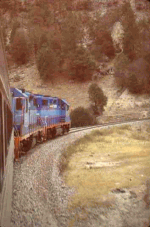 The train ride travels through several climes. The higher elevations feature four species of pine and fifteen species of oak of a deciduous forest. Octopus and cowhorn agaves, tree morning glory, papaya, orange, and kumquat trees can be spotted. Kapok trees, with their spiny-point bark, showed remnants of the cotton-looking flower used for pillow stuffing prior to the development of synthetic materials. A tropical thorny legume forest of cardon hecho, similar in appearance to the saguaro, and organ pipe cactus grow in the lower elevations near Los Mochis.
The train ride travels through several climes. The higher elevations feature four species of pine and fifteen species of oak of a deciduous forest. Octopus and cowhorn agaves, tree morning glory, papaya, orange, and kumquat trees can be spotted. Kapok trees, with their spiny-point bark, showed remnants of the cotton-looking flower used for pillow stuffing prior to the development of synthetic materials. A tropical thorny legume forest of cardon hecho, similar in appearance to the saguaro, and organ pipe cactus grow in the lower elevations near Los Mochis.
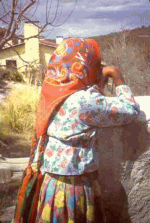 Passengers will marvel at the challenges and obstacles faced building a railroad through this rugged countryside. In the “La Pera” tunnel. the railroad track makes a 180-degree turn while dropping a 100 feet in elevation. Rusty derailed cars can be occasionally spotted along the track, but the beauty of the Barranca del Cobre distracts the eye. Our group flew from Tucson, Arizona to Chihuahua City, Chihuahua. We took a bus to Creel and the next morning, we boarded the train in the Tarahumara village of Creel. Stopping for two nights in El Divisadero, we then continued the 219-mile train ride to the Mexican city of Los Mochis.
Passengers will marvel at the challenges and obstacles faced building a railroad through this rugged countryside. In the “La Pera” tunnel. the railroad track makes a 180-degree turn while dropping a 100 feet in elevation. Rusty derailed cars can be occasionally spotted along the track, but the beauty of the Barranca del Cobre distracts the eye. Our group flew from Tucson, Arizona to Chihuahua City, Chihuahua. We took a bus to Creel and the next morning, we boarded the train in the Tarahumara village of Creel. Stopping for two nights in El Divisadero, we then continued the 219-mile train ride to the Mexican city of Los Mochis.
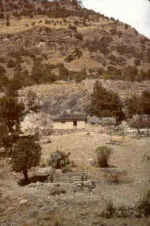 The luxurious Posada Mirador Hotel, in El Divisadero, perches on the rim of the canyon. All 30 rooms offer a balcony view of the Barranca del Cobre. A short hike leads to a small Tarahumara compound built into the canyon walls. Four of us took the day to explore the depths of Barranca del Cobre.
The luxurious Posada Mirador Hotel, in El Divisadero, perches on the rim of the canyon. All 30 rooms offer a balcony view of the Barranca del Cobre. A short hike leads to a small Tarahumara compound built into the canyon walls. Four of us took the day to explore the depths of Barranca del Cobre.
We hiked to the small rancho compound of Wakajipare. Our guide, Cecelio, brought his mule to serve, if necessary, as the “ambulancia.” The steep trails are not maintained, and have many loose rocks and slippery shale. We appreciated the agility of the Tarahumara who run these narrow trails in leather thongs. Our seven-mile hike had a 2000-foot drop in elevation, which gave us renewed respect for the athleticism of the Tarahumara.
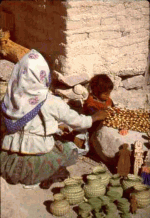 The only modern convenience in the small compound of Wakajipare was a corn grinder. This utensil replaced the stone metate. While the husband worked the field using yoked oxen to pull a wooden plow, his wife stopped nursing her baby to sell us some trinkets and a warm coke.
The only modern convenience in the small compound of Wakajipare was a corn grinder. This utensil replaced the stone metate. While the husband worked the field using yoked oxen to pull a wooden plow, his wife stopped nursing her baby to sell us some trinkets and a warm coke.
Take this wonderful train adventure soon! A road from Los Mochis to El Divisadero is on the drawing boards, and any additional access will bring more tourism to Barranca del Cobre and the Tarahumara. Ceremonial traditions and customs are fading fast. Men no longer wear their traditional loincloth, but if you hurry, you can still observe the women in their colorful dresses and headscarves.
